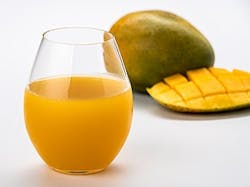Hydrocolloids are essential ingredients in food processing, and providers of these ingredients are constantly innovating to develop new and better solutions. Among recent developments are alternatives to locust bean gum; several new starches; and multifunctional ingredients that solve problems with fewer ingredients.
Locust bean gum alternatives
Locust bean gum is a vital hydrocolloid derived from the seeds of the carob tree, which is native to the Mediterranean region. The ingredient, which commonly comes in the form of a yellowish or white powder, is known chemically as galactomannan and consists of high-molecular-weight hydrocolloidal polysaccharides. Locust bean gum also is known as LBG, carob bean gum and carobin.
It's used in countless applications, from thickening sauces to improving mouthfeel in desserts. Since LBG is derived from a plant, it is perfect for plant-based, vegan and clean-label foods. Incidentally, it also is used in many non-food applications, such as in paper making, cosmetics and cigarettes.
In short, LBG is a fantastic hydrocolloid. But there’s a serious problem: There is not enough of it to meet demand. Carob trees take seven years before they can produce pods and 15 years to mature, which means suppliers cannot meet demand simply by planting more trees.
“As manufacturers are developing new products to target clean label needs, we have seen a rise in the demand for LBG,” explains Linda Dunning, systems business development manager-Americas for IFF. “However, after multiple years of below average to average crops, with little to no locust bean kernel carryover, the industry is facing an unbalanced supply to meet demand.”
Ulrich Zuber, a specialist in hydrocolloids for Unipektin, says LBG prices have spiked to unprecedented levels this year.
"We are at a historical price level for locust bean gum," Zuber says. "The fact is that locust bean gum is considered a natural hydrocolloid and people prefer that. The prices also are a result of consumer behavior during the corona pandemic -- people are staying at home and eating bagels with cream cheese for breakfast."
Zuber says the next crop of carob beans will be harvested in September, and indications are that it will be a good crop, which should decrease prices.
"Until then we'll need to live with very high prices," he says.
There are some alternatives to LBG in processed food. Guar gum and tara gum are also classified as galactomannans, and they have some of the same functionalities as LBG. Like LBG, guar gum and tara gum are derived from beans—guar gum comes from a legume called guar beans and tara gum is made by grinding the endosperm of seeds from the tara tree.
Two other gums used in some LBG replacements are derived from bacteria. Xanthan gum is made from a fermentation of glucose and sucrose inoculated with Xanthomonas campestris, and gellan gum is produced by the bacterium Sphingomonas elodea, which was first discovered in lily plant tissue.
These gum hydrocolloids are often used in combinations to meet specific needs.
Dunning says IFF considers many factors when creating a hydrocolloid combination that reduces or replaces LBG in a product.
"For example, we need to understand the customer’s marketing position of their finished product, such as non-GM, organic, clean label or 'free from' positioning," Dunning explains. "We also need to consider what functionality the LBG is delivering in the product and how it might be working synergistically with other ingredients. When we consider these factors and others, then our team can target potential alternatives to reduce or remove LBG from the finished product."
IFF offers a blend under the Grindsted System Blends brand that includes guar gum or xanthan gum and a reduced quantity of LBG that is ideal for cream cheese. Another blend in that system includes tara gum and guar gum and is designed for dairy and plant-based frozen desserts.
Unipektin also offers blends of guar gum, tara gum and other hydrocolloids to replace or reduce LBG in processed food recipes, Zuber says. The desired characteristics of the final product—price, labeling, taste, etc.—go into the decision about which hydrocolloids to use.
"You have plenty of hydrocolloids you can play with to get the texture and other characteristics you require," Zuber says. "But at the end of the day, every food product has to be delicious."
CP Kelco, which pioneered the commercial applications of xanthan and gellan gum, recently introduced new grades of Kelcogel Gellan Gum.
"Kelcogel offers dual functionality by providing both long-lasting suspension and mouthfeel," says Neil Morrison, head of global sales technical service for CP Kelco. "It can represent cost savings for formulators and a way to achieve fewer ingredients on the label."
New non-gum hydrocolloids
Sometimes a food processor's hydrocolloid needs can be met with a non-gum hydrocolloid, such as a starch. Starch is a complex polysaccharide that is widely found in natural sources such potatoes, corn and rice.
"Starch is the most commonly used hydrocolloid thickener, the reason being it is relatively cheap, abundant and possibly it does not impart any noticeable taste if used at a low concentration of 2 to 5%," explain researchers Dipjyoti Saha and Suvendu Bhattacharya in the Journal of Food Science and Technology. "Further, as starch is a common ingredient of many foods we encounter, addition of starch does not offer any foreign taste, which may not be true for different gums."
Tate & Lyle's new Stamist emulsifying starches improve viscosity and add new functionalities for mayonnaise and many other products.
There are a number of new starches on the market. For example, Tate & Lyle recently expanded their line of Stamist emulsifying starches.
"Stamist starches are designed to improve viscosity and add new functionalities for beverages, flavor concentrates, encapsulated flavors, coffee creamers, dressings and more," says James Smoot, director of R&D Texturants for Tate & Lyle.
"Starch emulsifiers help to stabilize and prevent separation of emulsions to maintain texture of foods and beverages during storage," he continues. "For example, in beverages, Stamist controls viscosity and stabilizes refrigerated beverages for long periods. These new starch emulsifiers can also replace egg yolk in dressing emulsions, allowing for tastier vegan formulations."
CP Kelco recently introduced an organic-compliant pectin, which also is a starch. Morrison says the new product simplifies the process of making fruited yogurt drinks. "Add this new grade of Genu Pectin to the fruit preparation and the stabilization carries over to the yogurt," Morrison explains.
Kelcogel Gellan Gum provides both long-lasting suspension and mouthfeel; plus it can enable cost savings for formulators and a way to achieve fewer ingredients on the label. Photo: CP Kelco
Cargill has expanded its SimPure starch line by adding tapioca starch to their existing line of corn- and potato-based starches. Tapioca starch is derived from the roots of the cassava plant. Adding tapioca to the other starches creates nuances that help food processors in certain applications, explains Shiva Elayedath, senior technical service manager for starch at Cargill.
Cargill's new tapioca starches are found in two lines, SimPure 996 and SimPure 999. All of them are Non-GMO Project Verified and have a neutral flavor profile. The starches in the 996 line create soft gel textures and are suitable for spoonable yogurts and meat alternatives. The 999 line starches are non-gelling, and are designed for stirrable yogurts, pumpable fruit preps and other applications that require a thick-but-fluid texture.
"Tapioca starches in the SimPure 996 series are high process tolerant starches and bring key sensory and functional attributes together, offering a creamy mouthfeel, while delivering excellent water-binding properties and good cold-storage stability," Elayedath says.
"The SimPure 999 series starches deliver creamy, indulgent textures thanks to their fat-mimetic properties. They offer excellent cold-storage stability, controlling syneresis over shelf life and are a good choice for kettle-cooked soups, sauces and ready meals."
Hydrocolloids continue to evolve as food trends evolve. For example, consumers have demanded more protein and health-enhancing benefits in their food, and hydrocolloids help with the suspension of protein and immune-boosting ingredients, Morrison notes.
"Sugar reduction is another dominant theme across multiple segments, from confectionery, beverages and condiments to yogurts and ice creams," Morrison says. "A simple replacement with a high-intensity sweetener may not provide a similar taste. Hydrocolloids such as gellan gum or pectin can help recover some of the body and texture that’s lost when sugar is reduced."
Interestingly, another trend supported by hydrocolloids is online grocery shopping, Morrison asserts. "Along with it, we have seen a need for longer shelf-life products that can handle warehousing. They require long-term stability, which hydrocolloids can provide."
In short, ingredient suppliers continue to create and modify hydrocolloids—whether gums, starches or combinations—to meet the food industry's needs.




